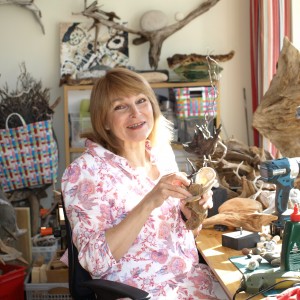I love the beauty of the natural world and want to show it in a fresh new light. My happiest childhood memories are beachcombing on the Italian Riviera or playing in the clear mountain streams of Austria on holidays with my parents. After studying Art and Craft, Design and Technology at Braunschweig University I went on to teach Art in London and then Head of Department for Design & Technology in a preparatory school in Berkshire. It still is one of the most rewarding things in my life to pass on my enthusiasm to the next generation.
Developing the sculptures has enabled me to give new value to natural things and has brought me closer to our creator. The process of making the sculptures has a meditative effect, ‘listening’ to the pieces of wood and experimenting to find which combination would create best harmony. A large variety of materials in different sizes and textures is necessary.
The individual pieces of driftwood have their own sculptural language and history. Each one needs to be handled without destroying its character. I aim to respect the shape and the history of each piece because every one is totally unique and deserves to be treated as such. Time and the elements have shaped these pieces for a reason.
Over time, driftwood develops a velvet-like surface where the wood fibres have been bleached by the sun and salt, and lifted through frost and rain. The combination of the wood with other organic or found materials and the absolute minimum of change, leads to the formation of new ‘relationships’.
Harmony plays a big role in my work. The hardness of the stone – albeit in the softness of its shape, contrasts with the soft texture of the driftwood. Conversely, the rounded shapes of the pebbles contrast with the rugged or more textured parts of the wood. My training in textiles, art and design all come together to help choose the ‘right’ technique.
Each of the sculptures demands a fresh approach and I treat it as a challenge. Newly found materials often influence the choice, inspiring fresh combinations.
Every pebble has to be special in shape, colour, texture and size, and has been collected by hand. It requires travelling to many different coastlines in Britain, ranging from Cornwall to the Highlands of Scotland in order to find these gems.
Movement plays an important part and I have been fascinated by the sculptures of Calder since my childhood. The interdependence of size, weight and distance creates wonderful tension and interesting dynamics. The slightest airflow can often make the sculpture swing and come alive. Due to this many sculptures have adjustable elements which you can change to suit your mood or the sculptures’ environment. Equally, Barbara Hepworth’s work has had a great impact on me with her use of curves, circles, openings and convex and concave shapes.
It is my mission to show the beauty and harmony of our wonderful natural world and its creator. By lifting the materials out of their usual contexts and combining them in unusual ways they take on a renewed vigour of expression. We have a chance to wake up and see the often surprisingly precious effects. We can remember the value of the natural world to us humans and hopefully act protectively towards nature in future.

